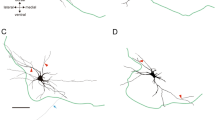Abstract
INNERVATION of arthropod excitatory muscle is of two types, distinguished by mechanical effect; these are “fast” (twitch) and “slow” (tonic), and only in the fast type is there a significant mechanical response to a single nerve impulse. The classes Insecta and Crustacea are the only arthropods the neuromuscular mechanisms of which have been studied in any depth, and considerable differences have been found between them, both in the anatomy and in the form of electrical events which accompany the fast and slow mechanical responses. Nearly all insect muscle fibres are fast-innervated and the electrical response is large, with a non-propagated spike component (active membrane response). Some fibres are also slow-innervated, and in these the electrical response is much smaller, but summates and facilitates greatly to repetitive stimulation, producing large depolarizations1–5. In crustaceans there are relatively fewer fast-innervated fibres, but all are slow-innervated. The two types of response are often difficult to distinguish electrically, and the fast response has no spike component; summation is incomplete although facilitation can be significant, and large depolarizations to either fast or slow stimulation are very rare6,7. Investigations of some of the more primitive insects could possibly show some responses which do not have the large spike activity of the higher insects, and some interesting neuromuscular patterns have been discovered in dragonfly larvae (species of Aeschna) which are thought to be primitive for several other reasons.
This is a preview of subscription content, access via your institution
Access options
Subscribe to this journal
Receive 51 print issues and online access
$199.00 per year
only $3.90 per issue
Buy this article
- Purchase on Springer Link
- Instant access to full article PDF
Prices may be subject to local taxes which are calculated during checkout
Similar content being viewed by others
References
Becht, G., Hoyle, G., and Usherwood, P. N. R., J. Insect Physiol., 4, 191 (1959).
Cerf, J. A., Grundfest, H., Hoyle, G., and McCann, F. V., J. Gen. Physiol., 43, 377 (1959).
Hoyle, G., J. Exp. Biol., 44, 413 (1966).
Wood, D. W., J. Exp. Biol., 35, 850 (1958).
Hoyle, G., in Recent Advances in Invertebrate Physiology (edit. by Scheer, B. T.), 73 (University of Oregon Press, Eugene, 1957).
Doral Raj, B. S., J. Cell. Comp. Physiol., 64, 41 (1964).
Hoyle, G., and Wiersma, C. A. G., J. Physiol., 143, 413 (1958).
Usherwood, P. N. R., and Grundfest, H., J. Neurophysiol., 28, 497 (1965).
Dudel, J., and Kuffler, S. W., J. Physiol., 155, 514 (1961).
Wiersma, C. A. G., and van Harreveld, A., Physiol. Zool., 11, 75 (1938).
Author information
Authors and Affiliations
Rights and permissions
About this article
Cite this article
MALPUS, C. Electrical and Mechanical Responses of the Skeletal Muscle of a Primitive Insect. Nature 215, 991–992 (1967). https://doi.org/10.1038/215991a0
Received:
Revised:
Issue Date:
DOI: https://doi.org/10.1038/215991a0
Comments
By submitting a comment you agree to abide by our Terms and Community Guidelines. If you find something abusive or that does not comply with our terms or guidelines please flag it as inappropriate.



